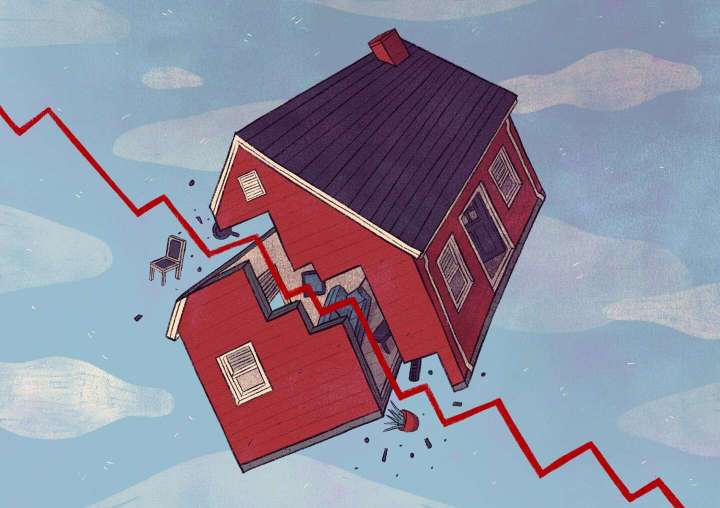After weeks of dramatic moves, mortgage rates took a small step back this week.
Mortgage rates wander lower after weeks of volatility

Freddie Mac, the federally chartered mortgage investor, aggregates rates from around 80 lenders across the country to come up with weekly national averages. The survey is based on home purchase mortgages. Rates for refinances may be different. It uses rates for high-quality borrowers with strong credit scores and large down payments. Because of the criteria, these rates are not available to every borrower.
The 15-year fixed-rate average dropped to 4.55 percent with an average 0.7 point. It was 4.59 percent a week ago and 2.16 percent a year ago. The five-year adjustable rate average slipped to 4.39 percent with an average 0.3 point. It was 4.43 percent a week ago and 2.43 percent a year ago.
“Mortgage rates have steadied after a few weeks of big up-and-down swings as bond markets found little impetus to move in either direction,” said Holden Lewis, home and mortgage expert at NerdWallet. “As mortgage rates stood relatively still, the number of people applying for mortgages dropped to the lowest level since 2000. This year’s rapid rise in mortgage rates and home prices has discouraged buyers. On top of that, would-be buyers increasingly believe that house prices will fall, so they’re shelving their homebuying plans for now, hoping to buy at lower prices later. That’s why mortgage applications are at a 22-year low.”
The minutes from the Federal Reserve’s July meeting released this week showed no indication that the central bank is considering pulling back on its interest rate hikes, even though Fed officials noted that housing activity had “weakened” and that the slowdown would likely continue. The Fed has raised the federal funds rate four times this year in an effort to tame inflation.
Before slowing the rate increases, Fed officials first want to see inflation decrease substantially. The most recent data for July revealed that inflation was up 8.5 percent annually, but flat month-to-month. Most economists expect the Fed to increase its benchmark rate by 50 or 75 basis points at its September meeting. (A basis point is 0.01 percentage point.)
“Mortgage rates remain elevated as the Federal Reserve’s actions to bring the economy down to a ‘soft landing’ may be starting to work,” said Lisa Sturtevant, chief economist at Bright MLS. “The better-than-expected July jobs report suggests that the overheated economy may be cooling without damaging the labor market. Recession risks may be easing, which has investors moving out of the relatively safe bond market.”
The yield on the 10-year Treasury grew to its highest level since late July this week, closing at 2.89 percent on Wednesday. Yields move in the opposite direction of prices.
Rick Sharga, executive vice president of market intelligence at Attom Data Solutions, a real estate data and analytics firm, says looking at the difference between long-term bond yields and mortgage rates may indicate that rates have peaked.
“One of the things that suggests we may be at or near a cycle high for mortgage rates is the higher-than-normal spreads between yields on the 10-year U.S. Treasury and rates on 30-year fixed-rate loans,” Sharga wrote in an email. “Recent Treasury yields have been between 2.8-2.9 [percent], which would normally mean rates on a 30-year mortgage between 4.25-5.0 [percent]. So today’s interest rate of nearly 5.5 [percent] is anywhere from .50 to 1.25 [basis] points higher than we’d normally expect to see. While there’s no guarantee that rates might still not go up a bit higher, this relatively high spread suggests that there’s actually room for mortgage rates to come down marginally in the near future.”
Bankrate.com, which puts out a weekly mortgage rate trend index, found more than half the experts predict rates will go up in the coming week.
“Inflation news from the UK has bond markets selling off,” said Michael Becker, branch manager at Sierra Pacific Mortgage. “The headline inflation number in the UK hit 10.1 percent, above the forecast of 9.8 percent. Core inflation also exceeded forecast. This serves as a reminder that central banks still have some work to do in regards to bringing inflation down. This will lead to higher mortgage rates.”
Bloomberg News reported this week that Wells Fargo, once one of the nation’s largest residential mortgage lenders, was pulling back from the mortgage market. According to the story, a variety of factors contributed to the decision. Home loans have been on the decline since mortgage rates skyrocketed earlier this year. Wells Fargo has faced stiff competition from non-bank lenders. And by reducing its home loan activities, Wells Fargo is less likely to face regulatory risk. The bank was fined $250 million by regulators last year for its past practices in its mortgage business.
Meanwhile, mortgage demand declined last week to its lowest level in 22 years. The market composite index — a measure of total loan application volume — decreased 2.3 percent from a week earlier, according to Mortgage Bankers Association data.
The refinance index fell 5 percent from the previous week to its lowest level since November 2000. It was 82 percent lower than a year ago. The purchase index slipped 1 percent. The refinance share of mortgage activity accounted for 31.2 percent of applications.
“While overall mortgage application activity fell slightly this week, mortgage rates continued their downward trajectory and have now fallen more than [a half-percentage point] since June, providing some relief to borrowers,” Bob Broeksmit, MBA’s president and chief executive, wrote in an email. “MBA still expects that both mortgage rates and home price growth will moderate, bringing more prospective buyers into the market by the end of the year.”






